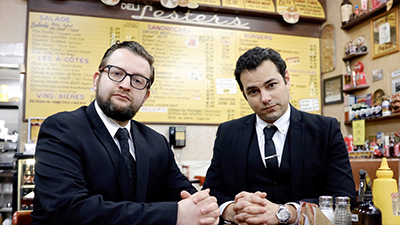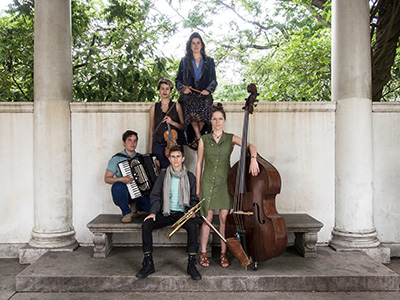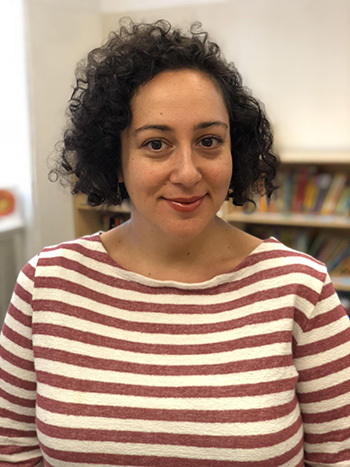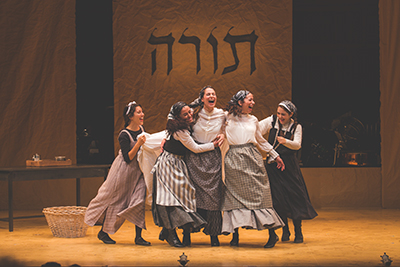Arts
Theater
A New Generation Is Reclaiming Yiddish

There’s a scene in the popular web comedy YidLife Crisis in which Chaimie, a 20-something Montrealer, inserts himself into a Yiddish conversation to defend the controversial presence of kosher samosas at a post-bris brunch.
“A Yiddish speaker!” marvels the mohel, also in the mameloshen (mother tongue, a colloquial term for Yiddish) in response to Chaimie. “Zeyer sheyn! Very nice!” exclaims an older woman enmeshed in the gastronomic quibble, distracted by the novelty of a Yiddish-speaking millennial. Then, miffed at being schooled about the samosas, she adds: “Your grammar is off a little.”
The verb tenses were beyond my ken, but even I—a non-speaker, watching on YouTube and thankful for the subtitles—could detect the decidedly New World ring of Chaimie’s Yiddish, peppered as it was with the lingo of North America circa 2018: Instagram, samosa, poutine (that Quebec classic of gravy-and-cheese-curd-smothered French fries, a reminder that YidLife Crisis is set in Montreal). More than two million people have viewed the web series, which premiered in 2014 and featured actress Mayim Bialik in one episode; the third season launched in September.
Chaimie and his sidekick, Leizer, played by Jamie Elman and Eli Batalion, respectively, joke about speaking their grandparents’ language, but the joke is on our outdated image of Yiddish speakers. The two main characters comfortably mix their native French and English with the mameloshen (“un, deux, trois, nosh!” they say, biting into a bagel). The pair are emblematic of how a younger generation is reclaiming Ashkenazi cultural heritage in its language of origin—what Rutgers University Jewish studies professor Jeffrey Shandler has dubbed Yiddish’s “post-vernacular” era.
“In the past 10 to 15 years, Yiddish has gotten more hip,” observed Yankl-Peretz Blum, 35, a New York-based Yiddish teacher who grew up learning Hebrew in modern Orthodox day schools, then stumbled onto Yiddish as a college student at the University of California, Santa Barbara. Once dismissed as part of a dying culture and the secret language of grandparents, or associated with Hasidic Brooklyn enclaves, Yiddish language and culture are now seen as “alternative and different from” mainstream Jewish culture, Blum said, “in a good way.”
Indeed, contemporary Yiddish-lovers are driving a wave of cultural expression unprecedented in modern memory: plays, podcasts, publications, klezmer concerts, festivals and language classes. In downtown Manhattan, the National Yiddish Theatre Folksbiene’s all-Yiddish production of Fiddler on the Roof, helmed by Broadway legend Joel Grey, has drawn record audiences—over 40,000 as of mid-October—for the 103-year-old company.

When I was a regular at Barbès and other Brooklyn nightclubs in the early 2000s, the ethnic-cool lineup had yet to include the klezmer-influenced sounds ubiquitous today. Back then, it was also hard to imagine audiences flocking to see Fiddler performed in the language of the shtetl. Less than 20 years later, bands like Litvakus, a New York-based “shtetl disco” group that plays Belarussian and Litvak folk music, and Tsibele, an ensemble of women and non-binary musicians that draws its politically focused Yiddish songs from what its members call “the edges of klezmer,” regularly sell out Brooklyn venues.
The recent Yiddish-language production of Death of a Salesman at the New Yiddish Rep generated buzz in New York theater circles; the Manhattan theater company’s production included Episcopalian Yiddishist Shane Baker as well as its managing director, Eli Rosen, one of a growing number of ex-Hasids prominent in Yiddish theater.
Further evidence of the popularity of the language and culture: Enrollment is up 50 percent from a decade ago at YIVO Institute for Jewish Research’s language, literature and culture summer course; The Workmen’s Circle, a 118-year-old Jewish social justice and cultural organization, offers dozens of popular Yiddish classes online and in Manhattan. Yiddish, like everything else, has gone digital, with Twitter forecasts (@YiddisheWeather) and podcasts like Vaybertaytsh, a Jewish feminist digest.
So, vos kumt for mit di yungelayt? What’s up with the young people? “Younger Jews are connecting to a heritage their assimilation-minded elders had discarded,” said Zalmen Mlotek, the Folksbiene’s longtime artistic director and Fiddler’s musical director. “There’s a generation that is yearning,” said the 67-year-old who has watched Folksbiene audiences get younger over the last decade. “They’re saying, ‘What is that culture, that language that was kept from me, that’s a part of my DNA and that touches me—even though I don’t understand the words?’ ”
Having grown up with a smattering of Yiddish expressions—bubbe meises, schmatte—I was surprised by how many words I did understand at a recent sold-out Folksbiene performance of Fiddler, though I definitely appreciated the English and Russian supertitles.
From Yente’s wheedling cadences (played by the scene-stealing Emmy winner Jackie Hoffman) to daughter Hodl’s poignant tribute, “Vayt Fun Mayn Liber Heym” (“Far From the Home I Love”), Yiddish imbues the mid-20th-century Broadway libretto with an Old World humor and fatalism I hadn’t realized was missing—but now cannot imagine Fiddler without. Most of all, I was stunned by how much more authentic Tevye (played by Steven Skybell) sounded talking to God in what was, after all, his native tongue. It’s a sign of how mainstream Yiddish has become that the Folksbiene was able to cast top non-Yiddish-speaking actors in Fiddler—and that my fellow theatergoers were old and young, Jewish and non-Jewish, secular and religious, Russian-, Yiddish- and English-speaking.

Allen Lewis Rickman, a veteran Yiddish actor, is not at all surprised by the success of the Folksbeine production. Yiddish “is the aural environment that the story lives in,” he explained. “You get a texture from the sound of the language.”
Rickman, 58, learned to speak the language from his immigrant parents and has made a career of it, including a turn as the shtetl dweller Velvel in the Coen Brothers’ 2009 film A Serious Man. Most recently, Rickman directed and starred in the New York run of Tevye Served Raw, adaptations of stories by Tevye creator Sholom Aleichem. Yet all too often, when he tells his friends about a Yiddish production, the response, he said, is
“ ‘Great! I’ll tell my grandmother.’ ”
In reality, the impassioned drivers of Yiddish culture I spoke with—actors, writers, scholars—were mostly between 25 and 45. They all knew each other, too: “People come for the Yiddish and stay for the Yiddishists,” Blum noted. Many enthusiasts, like Blum, get hooked on the language or klezmer music, then join a community of artists, musicians, performers and academics who circulate professionally among organizations like YIVO, The Workmen’s Circle, The Yiddish Book Center in Amherst, Mass., and klezmer events.
“Yiddish as a living culture changes and grows with the times,” reflected Sarah Mina Gordon, who in 2015 co-founded Yiddish New York, an annual December festival that attracts thousands to klezmer concerts, dance parties, jam sessions and language meetups around Manhattan.
A fourth-generation Yiddish singer, Gordon, 39, grew up going to KlezKamp, the New York klezmer festival co-founded by her mother, Adrienne Cooper. Like many non-Hasidic Yiddish-speakers today, Gordon learned the language as a curious adult. Like many of her fellow Yiddish innovators, she put her own spin on the culture: She’s the founder and lead singer of Yiddish Princess, a heavy metal band that fuses Yiddish lyrics with vibrating synth chords.
Jordan Kutzik, a culture writer for the Forverts—The Forward’s Yiddish edition, established in 1893 and available online in Yiddish and English—is another influencer dedicated to ensuring the Jewish future has a bit of Yiddishe tam (Yiddish flavor). Kutzik, 30, grew up singing Yiddish songs at his Philadelphia Sunday school and playing klezmer violin; he honed his fluency at Lithuania’s Vilnius Yiddish Institute. Today, as chair of the New York-based youth organization Yugntruf, he helps organize the annual Yidish-Vokh summer retreat, which attracts about 150 people, many of them families with young children.
“Over the past 10 years, I’ve seen a generation of kids grow up and speak Yiddish” at Yidish-Vokh, said Kutzik, whose latest project is spearheading Yugntruf’s fledgling children’s book imprint, Kinder-Loshn Publications. (The imprint’s first Yiddish-English bilingual books, re-illustrated classics from the early 20th century, are due out in 2019.) Having practiced speaking with the prewar generation, Kutzik is acutely aware that the language’s future depends on people like him. YIVO broadly estimates there are 500,000 to 1 million speakers of Yiddish worldwide, from fluent speakers to those currently learning the language—a far cry from the 11 million who spoke the language before the Holocaust. A growing majority, like Kutzik, are American-born.

For Yiddish teacher Blum, who has had a succession of Yiddish-speaking roommates, the mameloshen has been a gateway to “a whole world I had no idea about,” he said. Blum is also the creator of YiddishPOP, a language-learning website.
Rokhl Kafrissen, a 40-something cultural critic whose Tablet Magazine column, “Rokhl’s Golden City,” digests Yiddish goings-on around New York, had a similar epiphany as a teenager when she stumbled across a klezmer record.
Like many of their colleagues, Blum and Kafrissen talk of finding Jewish authenticity in a language that encompasses a thousand-year, particularly Jewish worldview. “Yiddish is never just a language,” Kafrissen said. For many who are turned off by mainstream, synagogue-and-Israel-oriented Judaism, she added, “embracing Yiddish is a way of embracing an organic Jewish life.”
Yiddish is also the quintessential language of Jewish exile—a quality that resonates deeply with modern audiences, noted Rob Adler Peckerar, executive director of the Los Angeles-based cultural organization Yiddishkayt, which produces YidLife Crisis as well as Monsa Monster, a monthly storytelling podcast of Yiddish classics in English. “Displacement and immigration is the status of most people in the world today,” said Peckerar, 44, who fell in love with Yiddish as an undergraduate at the University of California, Berkeley. “We see in Yiddish a model of diverse people coming into contact and being creative.” On the less traditional West Coast, he added, many Jews turned off by organized religion “are drawn to the Yiddish legacy of social justice activism.”
Some Yiddish enthusiasts feel that legacy is more relevant in English. The team behind Theater J, the in-house ensemble of the Edlavitch Jewish Community Center in Washington, D.C., conceived its new Yiddish Theater Lab to reintroduce forgotten, century-old Yiddish classics in English. “They were written in Yiddish for its accessibility for Jewish audiences then,” explained Adam Immerwahr, Theater J’s 36-year-old director. “We’re saying, let’s hear this literature in the most accessible way possible today. You don’t expect Chekhov to be performed in Russian.”
So far, the approach is popular with audiences, 40 percent of whom are not Jewish. Yiddish Theater Lab sold out every staged reading in its inaugural year, and in March will premiere its first full-scale production, The Jewish Queen Lear, originally written in 1898 by Russian-born American playwright Jacob Gordin.
In New York, at least—home to America’s greatest concentration of both Jews and Yiddish speakers—the trend is undeniably toward more use of the mameloshen in Ashkenazi cultural happenings, not less. “In the past, people would try to translate everything into English,” said Mlotek, the Folksbiene director. “Now people are asking me: ‘How can we do this in Yiddish?’ ”
Yiddish Culture Guide—A Sampling
New York, N.Y.
Fiddler on the Roof (in Yiddish) through December 30, National Yiddish Theatre Folksbiene, Museum of Jewish Heritage
“Ruth Rubin’s Legacy of Yiddish Song” featuring Sarah Mina Gordon, December 23, YIVO Institute for Jewish Research
Yiddish New York festival, December 22 to 27 (yiddishnewyork.com)
Vartn Af Godot (Waiting for Godot) December 24 to January 27, 2019, New Yiddish Rep
“From Shtetl to Stage: A Celebration of Yiddish Music and Culture” featuring Evgeny Kissin, Frank London and Daniel Kahn, April 15, 2019, Carnegie Hall
Las Vegas, Nev.
Yiddish Las Vegas festival, February 22 to 24, 2019, hosted by Temple Sinai
Washington, D.C.
The Jewish Queen Lear (Mirele Efros), about a wealthy widow’s relationship with her son and daughter-in-law, March 13 to April 7, 2019, Yiddish Theater Lab/Theater J
Cruise
Yiddish Kultur Voyages’s inaugural May 2019 Yiddish cruise tours Jewish Heritage sites along the Danube and includes lectures on the history of Yiddish-speaking communities in Europe and performances by klezmer musicians and singers
Hilary Danailova writes about travel, culture, politics and lifestyle for numerous publications.










 Facebook
Facebook Instagram
Instagram Twitter
Twitter
[…] recent years, more young Jews have started to learn and practice Yiddish; it’s even on Duolingo. As with many parts of North American and European […]